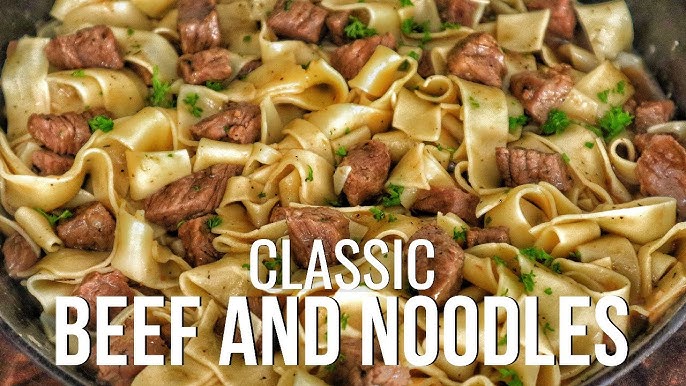Beef Noodle Recipe: Let’s talk about the kind of meal that warms your soul, fills your belly, and brings comfort with every single bite—beef noodles. Whether you’re trying to recreate a street-side Taiwanese favorite or just craving a hearty, home-cooked dish that screams flavor, beef noodles have got your back.
What makes beef noodles so special? It’s the marriage of tender, slow-cooked beef and chewy, slurp-worthy noodles, all soaking in a rich, savory broth that’s been carefully simmered to perfection. And let’s not forget the aroma—one whiff, and you’re transported to a cozy kitchen halfway across the world.
This recipe guide is your go-to map for crafting that bowl of perfection. We’ll break it all down—step-by-step—so even if you’re a kitchen newbie, you’ll nail this dish like a pro. Get ready for juicy beef, noodles with just the right bite, and a broth that’ll make you want seconds (or thirds). Let’s get started!
Ingredients You’ll Need
Before we turn on the stove, let’s talk ingredients. Quality is key when it comes to making a dish as layered and savory as beef noodles. Each element plays a role, from the beef down to the smallest spice. Here’s what you’ll need and why it matters.
Beef Cut Suggestions
When it comes to beef noodles, you want a cut that gets melt-in-your-mouth tender after simmering. Go for:
- Beef shank – rich in flavor with connective tissue that breaks down into silky gelatin.
- Chuck roast – affordable and marbled, which means more flavor.
- Brisket – takes time but yields incredibly juicy results.
Avoid lean cuts like sirloin—they dry out fast and don’t give you that tender pull-apart texture.
Noodle Options
Not all noodles are created equal! For beef noodles, aim for:
- Fresh wheat noodles – chewy and ideal for soaking up broth.
- Dried ramen or egg noodles – easily available and still delicious.
- Hand-pulled noodles (if you’re feeling adventurous) – the ultimate texture and authenticity.
Pro tip: Avoid rice noodles—they don’t hold up well in rich beef broth.
Aromatics and Vegetables
These are your base for flavor. Here’s what you’ll want:
- Garlic (5 cloves, smashed)
- Ginger (2-inch piece, sliced)
- Green onions (3-4 stalks, chopped)
- Star anise (2-3 pods) – adds depth and an unmistakable aroma
- Onion (1 whole, sliced)
Optional veggies for topping:
- Bok choy, spinach, or napa cabbage
- Pickled mustard greens (for a tangy twist)
Spices and Seasonings
This is where the magic happens:
- Soy sauce (dark and light – 2 tbsp each)
- Shaoxing wine (2 tbsp) – a splash brings out the beef’s umami
- Chili paste or Sichuan peppercorns (optional for heat)
- Sugar (1 tsp) – balances the salty-savory notes
- Salt and black pepper – to taste
Broth Base Options
You’ve got choices:
- Beef stock – rich and flavorful, preferably homemade or low-sodium if store-bought
- Water + beef bouillon – still works if you don’t have broth handy
- Add-ins for extra richness: a dash of fish sauce, miso paste, or even a spoonful of peanut butter (trust me—it deepens the flavor)
Gather everything before you start. Trust me, it makes the process smoother and way more enjoyable.
Preparation Before Cooking
Before diving into the heat, let’s prep like pros. Beef noodle soup isn’t difficult, but like any good recipe, it rewards patience and preparation. Mise en place (a fancy term for “everything in its place”) will save you stress later.
Marinating the Beef
Don’t skip this step—it infuses flavor and tenderizes:
- Cut beef into 1.5-inch chunks.
- Toss in a bowl with 2 tbsp soy sauce, 1 tbsp Shaoxing wine, and a sprinkle of black pepper.
- Let sit for at least 30 minutes (up to 2 hours) in the fridge.
This simple marinade works wonders. The wine breaks down the muscle fibers, and the soy gives a salty umami boost right from the start.
Chopping Vegetables
Slice, dice, and prep:
- Smash garlic and ginger (no need to mince, we’re going for bold infusions).
- Rough chop green onions and onion.
- Wash and halve any greens (bok choy or spinach).
Place everything in separate bowls. Trust me—trying to cut garlic while your beef is browning is a rookie move.
Prepping Noodles
Cook noodles according to package directions but go al dente. They’ll finish in the broth later and you don’t want mush. Rinse under cold water to stop cooking, then toss in a bit of oil to prevent sticking.
Some folks keep noodles and broth separate until serving to keep the noodles springy. Either way, prep them now so they’re ready to roll when your soup’s done.
Cooking the Beef
Alright, now we’re getting to the good stuff. This is where your kitchen starts to smell amazing. Browning and simmering the beef is the heart of this dish—it builds layers of flavor that no shortcut can replicate.
Browning the Meat
Get that crust:
- Heat 2 tbsp oil in a heavy-bottom pot or Dutch oven.
- Sear the beef in batches—don’t crowd the pan!
- Let each side brown for 2-3 minutes before flipping.
Why it matters: Browning creates the Maillard reaction—a fancy term for flavor gold. Don’t skip it.
Set the browned beef aside and move to the next stage.
Slow Simmering for Tenderness
Return the beef to the pot and add:
- Garlic, ginger, green onions, and onions.
- Stir for 2 minutes until fragrant.
Then add:
- 2 tbsp dark soy sauce
- 2 tbsp light soy sauce
- 2 tbsp Shaoxing wine
- Star anise
- 1 tsp sugar
Let it all mingle for a minute, then pour in enough beef broth to cover the meat (about 5-6 cups). Bring to a boil, then reduce to a low simmer.
Let it go low and slow for at least 90 minutes—up to 2.5 hours if you’ve got the time. The goal? Beef so tender it practically melts with a spoon.
Building the Flavorful Broth
This broth isn’t just soup—it’s the soul of the dish. We want it rich, fragrant, and complex. Whether you’re starting with a store-bought base or doing it all from scratch, this is where your beef noodles go from good to unforgettable.
Homemade vs Store-Bought Broth
If you’ve got time, homemade wins. Roast beef bones at 425°F for 45 minutes, then simmer with aromatics for 6+ hours. But store-bought low-sodium beef broth works just fine with the right additions.
Enhancing the Base
Add these to your simmering pot:
- 1 tbsp miso paste (adds umami depth)
- 1 dash fish sauce (optional but awesome)
- More soy sauce or salt to taste
If you like it spicy, stir in chili paste or a few Sichuan peppercorns. Let everything bubble gently for another 30 minutes to lock in the flavor.
Taste as you go. Adjust seasoning until it hits that sweet spot of savory, salty, slightly sweet, and aromatic.
Assembling the Bowl
Here’s where the magic finally comes together. You’ve prepped, simmered, and seasoned with care—now it’s time to plate (or rather, bowl). Assembling the perfect beef noodle bowl isn’t just about throwing everything in randomly. Think of it like layering flavor, texture, and visual appeal.
Layering the Components
Start with the base:
- Place a serving of cooked noodles in a large bowl.
- Gently ladle in that rich, steamy beef broth—make sure you get both liquid and a few pieces of beef in each scoop.
- Add any vegetables you’ve chosen, like bok choy or spinach. If raw, the hot broth will wilt them just enough.
- Top with your tender, juicy chunks of beef.
Finish strong with garnishes like chopped green onions, a sprinkle of fresh cilantro, or even a spoonful of chili oil for extra depth. A soft-boiled egg is also a game-changer if you want to add protein and richness.
Presentation Tips
Visual appeal matters. Use wide, shallow bowls so ingredients don’t pile up awkwardly. Let the beef peek out over the noodles, and drizzle a few drops of dark soy or sesame oil for shine and aroma.
Optional Toppings and Garnishes
If you want to take your beef noodles from comforting to restaurant-quality, it’s all in the toppings. They add brightness, texture, and that little something extra that keeps you reaching for the next bite.
Topping Ideas to Try
- Chili oil or chili crisp: Adds heat and crunch.
- Pickled mustard greens: A tangy contrast to the rich broth.
- Soft-boiled egg: Creamy and savory.
- Toasted sesame seeds: For a subtle nutty flavor.
- Fresh herbs: Cilantro, Thai basil, or green onions.
- Garlic chips: Crispy bits of fried garlic take this over the top.
Making It Your Own
Don’t be afraid to experiment. Some people love adding a splash of vinegar for brightness, or even a bit of hoisin sauce for sweetness. It’s your bowl—build it how you like it.
Serving Suggestions
Now that your bowl is picture-perfect, what else goes well with beef noodles? While the dish is a complete meal on its own, a few thoughtful additions can round out your spread.
Side Dishes to Serve
- Steamed dumplings: Pork, shrimp, or veggie dumplings are a natural companion.
- Spring rolls or egg rolls: Crunchy, savory, and satisfying.
- Light salad: A cucumber salad with sesame dressing refreshes your palate.
- Kimchi or pickles: Adds a tangy and spicy crunch.
Beverage Pairings
- Jasmine tea or green tea: Keeps the meal light and soothing.
- Chilled Asian beer: Perfect with the rich and spicy broth.
- Sparkling water with lime: Helps cut through the savory beef fat.
Storage and Reheating Tips
Got leftovers? Lucky you! Beef noodles store well and often taste even better the next day as the flavors meld together.
Storage Tips
- Refrigerate the broth and noodles separately to keep the noodles from getting soggy.
- Use airtight containers and store in the fridge for up to 4 days.
- Beef and broth can be frozen for up to 2 months.
Reheating Instructions
- Heat broth over the stove until steaming. Avoid boiling to keep the meat tender.
- Reheat noodles in hot water for 30 seconds or microwave briefly.
- Combine everything just before serving and top with fresh garnishes.
Pro tip: Add a splash of water or broth if the soup thickens too much in the fridge.
Tips and Tricks for Best Results
Want to take your beef noodles from good to unforgettable? A few pro tips can elevate your cooking and make the whole process smoother.
Flavor-Boosting Hacks
- Caramelize your onions for a sweeter, richer broth.
- Roast beef bones or add a roasted marrow bone to your broth for even more depth.
- Toast your spices (like star anise and peppercorns) before adding them in to release their oils and aromas.
Cooking Tips
- Don’t rush the beef—low and slow wins the race.
- Skim the surface of your broth as it simmers to remove impurities for a clearer broth.
- Let the soup sit for 10 minutes off the heat before serving. It helps the flavors settle.
Serving Tips
- Warm your bowls before adding noodles and broth to help keep everything hot.
- Always serve extra garnishes on the side so everyone can build their bowl to taste.
Common Mistakes to Avoid
Even a simple dish like beef noodles has its pitfalls. Avoiding a few common mistakes can make the difference between a bland bowl and one that’s packed with flavor and perfectly balanced.
Mistake 1: Using the Wrong Cut of Beef
Tough, lean cuts like sirloin or round just won’t do. They get dry and chewy instead of melting in your mouth. Always opt for cuts with marbling and connective tissue like beef shank, chuck, or brisket. These cuts break down during long cooking and create a rich, tender bite.
Mistake 2: Overcooking the Noodles
Noodles should be chewy and bouncy—not mushy. Always cook them al dente and rinse under cold water to stop the cooking process. Better yet, keep them separate from the broth until serving so they stay perfect.
Mistake 3: Rushing the Broth
The broth is the heart and soul of beef noodles. Don’t rush it. Simmering for less than 60 minutes won’t allow the flavors to fully develop. Patience pays off here. Let it simmer low and slow to coax out every bit of umami and richness.
Mistake 4: Forgetting to Skim the Broth
As the broth simmers, fat and impurities rise to the top. Skim it regularly with a spoon or mesh skimmer to keep the soup clear and clean-tasting. This step also prevents your broth from tasting greasy.
Healthier Version Alternatives
Love beef noodles but trying to eat a little lighter? You don’t have to sacrifice flavor to make a more nutritious version of this classic dish.
Lean Protein Substitutes
- Use lean beef cuts like eye round or flank, but marinate them longer and slice thin.
- Try ground beef or turkey for quicker cooking and lower fat content.
- For a vegetarian twist, use tofu, mushrooms, or plant-based meat alternatives.
Low-Sodium and Low-Fat Tips
- Use low-sodium soy sauce and broth to control salt levels.
- Skim fat from the top of the broth or refrigerate and remove the solidified fat before reheating.
- Add more vegetables to bulk up the meal and provide nutrients without extra calories.
Whole-Grain or Gluten-Free Noodles
- Swap regular noodles with whole wheat, brown rice, or buckwheat soba for added fiber and a lower glycemic index.
- Gluten-free? Go for rice noodles or gluten-free ramen options.
Flavor doesn’t need to be compromised when you use fresh herbs, aromatics, and just a bit of smart seasoning.
Variations from Around the World
Beef noodles may have originated in Asia, but they’ve taken on many delicious forms across the globe. Let’s look at some regional variations that might inspire your next version.
Taiwanese Beef Noodle Soup
- Deep, soy-based broth with star anise and Shaoxing wine
- Spicy chili oil finish
- Pickled mustard greens as topping
Vietnamese Pho Bo
- Light, fragrant broth made with charred onions, ginger, and spices
- Thinly sliced rare beef added right before serving
- Fresh herbs, bean sprouts, and lime on the side
Chinese Lanzhou Lamian
- Hand-pulled noodles in a clear beef broth
- Radish slices, fresh coriander, and chili oil
- Famous for its clear, non-oily presentation
Japanese Nikusoba
- Uses soba noodles and thinly sliced beef
- Often served with a soy-based dashi broth
- Topped with scallions and a raw egg yolk
Try experimenting with different regional styles to find your favorite or create your own fusion!
FAQs about Beef Noodle Recipe
1. Can I make beef noodles in a slow cooker?
Absolutely! Sear the beef first, then toss everything into the slow cooker and cook on low for 7-8 hours. You’ll get tender meat and a rich broth with minimal effort.
2. What can I use instead of Shaoxing wine?
If you don’t have Shaoxing wine, dry sherry or a splash of white wine with a pinch of sugar works well as a substitute.
3. Can I use chicken or pork instead of beef?
Sure! Chicken thighs or pork shoulder work great. Just adjust the cooking time accordingly since they cook faster than beef.
4. How do I store and reheat leftovers?
Store broth and noodles separately in airtight containers in the fridge. Reheat the broth on the stove and warm the noodles briefly in hot water before combining.
5. What’s the best way to make the broth even richer?
Roast beef bones and aromatics before simmering. Add ingredients like miso paste, mushroom powder, or a piece of kombu (dried kelp) for extra umami.
Conclusion
So there you have it—a full, step-by-step guide to making a bowl of beef noodles that’s bursting with flavor, texture, and comfort. Whether you’re whipping this up for a cozy night in or serving it to impress guests, this dish delivers every time.
From marinating the right beef cut to building a broth with soul, you’ve now got the tools to master this recipe. And with all the variations, topping ideas, and healthy tweaks, you can make this dish your own every single time.
Now grab those chopsticks, slurp up those noodles, and enjoy every bite of your homemade beef noodle soup. You earned it.



